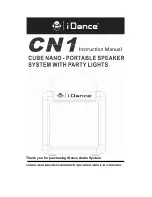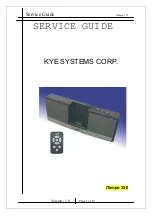
Button press
Function
Notes
Short press
Power on, power off
Long press
Enter special mode, exit
special mode
Press longer than 5 seconds
Special mode: one short
press
Mode 1: AES/EBU channel
A selected, room-related
calibration in use
Power button light blinks
once every few seconds
Short press advances
Mode 2: AES/EBU channel
B selected, room-related
calibration in use
Power button light blinks
twice every few seconds
Short press advances
Mode 3: AES/EBU channel
A selected, factory calibra-
tion in use
Power button light blinks
three times every few
seconds
Short press advances
Mode 4: AES/EBU channel
B selected, factory calibra-
tion in use
Power button blinks four
times every few seconds
Special selection: long
press
Once a special mode 1-4
has been selected, a long
press selects the special
mode
Press longer than 5 sec-
onds; the RAM-XL selects
the special mode and starts
playing. To exit the special
mode turn off the amplifier.
Special mode: no press for
60 seconds
RAM-XL exits the special
mode and turns off
Automatically happens if
user does not press the
power button
Table 2. Power button actions to activate testing modes
Testing Mode
Once on, when the power button is pressed
for a long time, the RAM-XL enters a mode
for system testing. This special mode
is intended for system debugging and
testing. When the RAM-XL is turned off,
the special mode is reset. Upon restarting
the RAM-XL the current standard settings
stored by GLM software are restored.
Test mode selection blinks the power
button light (see Table 2). A special mode
is activated by a long press on the power
button. In a special mode the power
button light remains on but blinks off
1-4 times indicating the mode currently
selected.
The testing modes are not intended for
continued operation. Use GLM software to
set up permanent settings for the 1236A.
Maintenance
Periodically check that the protective grille
on the cooling fan on the back panel of the
RAM-XL amplifier is clear of blockages.
Clean gently with a vacuum cleaner if
necessary. Increased fan noise can be an
indication of increased heat load due to a
blockage. In an extreme case the amplifier
may automatically shut off.
Safety Considerations
Although this product has been designed
in accordance with international safety
standards, to ensure safe operation and to
maintain the monitor under safe operating
conditions, the following warnings and
precautions must be observed:
• Servicing and adjustment must only
be performed by a certified Genelec
service. The monitor enclosure or the
RAM-XL amplifier unit must not be
opened.
• Do not use this product with an
unearthed mains cable or a mains
connection without the protective earth
contact as this may lead to personal
injury.
• To prevent fire or electric shock, do not
expose any part of the product to water
or moisture.
• Do not place any objects filled with
liquid, such as vases on or near any
part of the product.
• The ”Woofer” and ”Midrange/Tweeter”
connectors on the RAM-XL amplifier
can output hazardously high voltages.
To ensure safety, the wiring connected
to these connectors must be installed
by a qualified and trained person.
• Note that the amplifier is not
completely disconnected from the AC
mains service unless the mains power
cord is removed from the amplifier or
the mains outlet. Easy access to either
end of the power cord must be ensured
at all times.
• Sufficient clearances and free flow
of air around the RAM-XL amplifier
as defined in chapters Amplifier
Positioning and Operating Environment
are necessary to maintain sufficient
cooling.
Symbols
WEEE Directive 2012/19/EU
Power/standby switch
Compliance to FCC Rules
This device complies with part 15 of the
FCC Rules. Operation is subject to the
following two conditions:
• This device may not cause harmful
interference, and
• This device must accept any
interference received, including
interference that may cause undesired
operation.
Note: This equipment has been tested
and found to comply with the limits for
a Class B digital device, pursuant to
part 15 of the FCC Rules. These limits
are designed to provide reasonable
protection against harmful interference in
a residential installation. This equipment
generates, uses and can radiate radio
frequency energy and, if not installed and
used in accordance with the instructions,
may cause harmful interference to radio


























